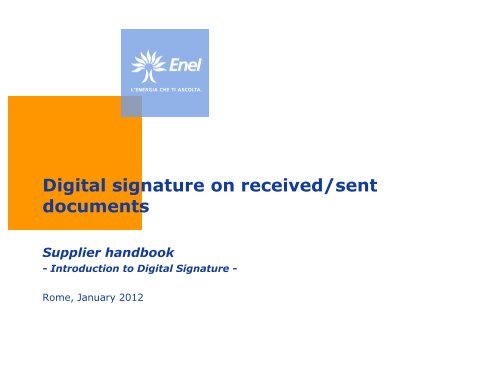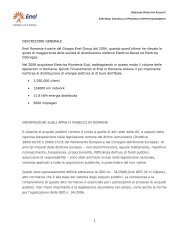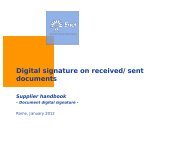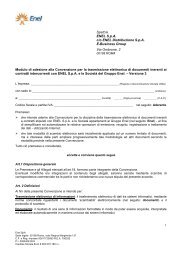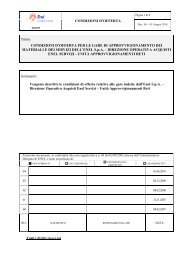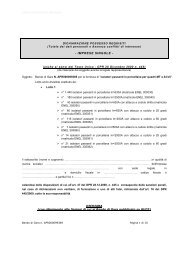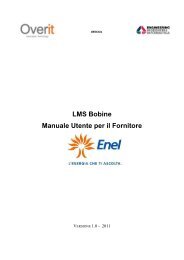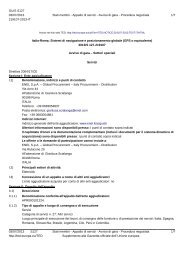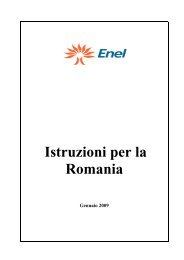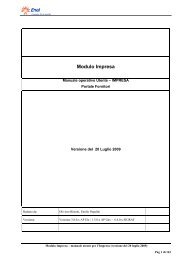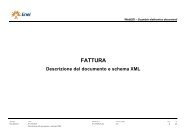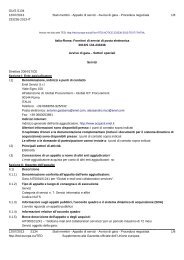Digital signature
Digital signature
Digital signature
You also want an ePaper? Increase the reach of your titles
YUMPU automatically turns print PDFs into web optimized ePapers that Google loves.
<strong>Digital</strong> <strong>signature</strong> on received/sent<br />
documents<br />
Supplier handbook<br />
- Introduction to <strong>Digital</strong> Signature -<br />
Rome, January 2012
<strong>Digital</strong> <strong>signature</strong> - overview<br />
• <strong>Digital</strong> <strong>signature</strong> is defined as an attestation system for digital document<br />
aimed to assure both the not denial and the document integrity<br />
• <strong>Digital</strong> <strong>signature</strong> posted on a document aims to satisfy the following three<br />
requirements:<br />
othe receiver is able to verify the sender identity (authenticity)<br />
othe sender can not deny a document signed by him (not denial)<br />
othe receiver can not modify a document signed by someone else<br />
(integrity)
<strong>Digital</strong> <strong>signature</strong> - features<br />
• To satisfy the requirements it is necessary that the digital <strong>signature</strong> tool:<br />
ois based on a cryptic asymmetric keys system<br />
oassures the messages content confidentiality, by preventing whom<br />
does not have the “key” (according to cryptic definition) from any<br />
interpretation<br />
oprovides each user with a pair of certified keys: one private key (not<br />
shared with anyone) for decoding the received messages and for signing<br />
the sent ones, and a public key available for other users in order to<br />
encode the messages sent to him and to decode/verify his <strong>signature</strong><br />
ouses keys issued by a certification authority subject to DigitPA<br />
surveillance<br />
ois created through a device with the highest security level<br />
(smartcard/USB token)
<strong>Digital</strong> <strong>signature</strong> operating flow<br />
Signature process (user A)<br />
• In the picture is reported the process followed by user A to sign a document:<br />
Signer<br />
Document Hash Digest<br />
Private key<br />
Crypto<br />
Signature<br />
(Cryptic digest)<br />
Envelope with<br />
document and<br />
<strong>signature</strong><br />
Public key<br />
1. The document to be signed is subject to hash algorithm<br />
to generate a digest that represents the document<br />
univocally<br />
2. The digest is encoded by using the signer private key<br />
and then the <strong>signature</strong> is generated<br />
3. Then document and related <strong>signature</strong> are inserted in an<br />
electronic envelope in order to create the signed<br />
document<br />
4. <strong>Digital</strong> <strong>signature</strong> is permanently linked to the electronic<br />
document in order to add important information used to<br />
verify its integrity, authenticity and not denial<br />
5. The user must have a proper kit (smart card, smart card<br />
reader and <strong>signature</strong> software). As an alternative for<br />
smart card, the user can use an USB token. Through<br />
these tools the user can digitally sign and apply<br />
timestamp to any documents
<strong>Digital</strong> <strong>signature</strong> operating flow<br />
Verification process (user B)<br />
• In the picture is reported the process followed by user B to verify a document:<br />
Receiver<br />
Signer<br />
sender<br />
Private key<br />
Envelope with<br />
document and<br />
<strong>signature</strong><br />
Document Hash Digest<br />
Signature<br />
(Cryptic digest)<br />
Digest<br />
Two digest are equal<br />
so the document is OK<br />
Comparison<br />
Public key<br />
1. Document and <strong>signature</strong> is extracted from the envelope<br />
2. The <strong>signature</strong> is decoded by using the signer public key<br />
(user A) and by extracting the original digest<br />
3. The document is subject to hash algorithm to create the<br />
current digest to be compared to the original contained<br />
in the <strong>signature</strong><br />
4. If the two digests are equal the document has not been<br />
corrupted and it has been signed by the private key<br />
owner who has encoded his <strong>signature</strong>
<strong>Digital</strong> <strong>signature</strong> validity<br />
• The owner certificate has a validity period, but it can be cancelled or<br />
suspended before the defined deadline (i.e.: <strong>signature</strong> device taking away or<br />
loss, not correctness of certificate information)<br />
• Certificate cancellation and suspension correspond to the missed <strong>signature</strong><br />
of the document<br />
• Cancellation is permanently, suspension is a temporary condition of<br />
the certificate that can be passed to “cancellation” or “suspension revocation”<br />
• Some criticalities could be related to the use of document digitally signed<br />
through certificate subsequently expired, cancelled or suspended<br />
• In this cases the timestamp tool enables the possibility to identify the<br />
exact moment in which the document has been signed and to<br />
demonstrate that in that moment the certificate was still valid
<strong>Digital</strong> <strong>signature</strong> – accepted document formats<br />
• Currently Italian law provides for three different document formats to produce<br />
file digitally signed:<br />
oP7M format -> available since 1999, it is the format that PA must accept<br />
oPDF format -> introduced in 2006, it is a standard format that not<br />
required any fees to anyone. It has a very wide diffusion and immediate<br />
availability (the reader software can be free downloaded from Internet)<br />
and it satisfies technical/legal requirements to manage digital <strong>signature</strong><br />
oXML format -> introduced in 2006 to boost the digital <strong>signature</strong> diffusion<br />
within sectors in which the xml language is typically used for electronic<br />
management of documents exchanges (i.e.: banking, public health)
<strong>Digital</strong> <strong>signature</strong> – Italian law<br />
• In Italy it is possible to create electronic documents with the same legal<br />
validity of paper document with manual <strong>signature</strong><br />
• The law framework has been set up since 1977 through the issue of act 59/97<br />
(art. 15) then evolved to receive the European guideline about electronic<br />
<strong>signature</strong> (Guideline 1999/93/CE) that lead to the issue of several<br />
amendments to create the current law framework<br />
• On DigitPA site is available a brief compendium and other information on<br />
digital <strong>signature</strong><br />
http://www.digitpa.gov.it/firma-digitale<br />
• At the following link is available the list of parties authorized to issue digital<br />
<strong>signature</strong> certificates<br />
http://www.digitpa.gov.it/certificatori_firma_digitale


